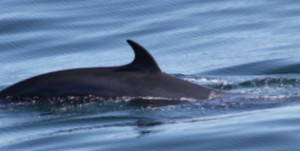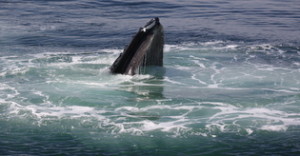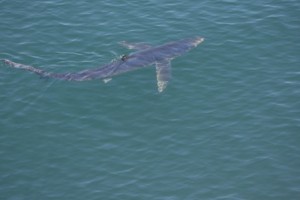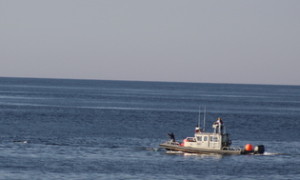Dolphin Fleet Naturalist Notebook – 14 August to 20 August
On August 14th our naturalist, Gwen, writes, “Today we found a fine group of humpbacks just south of the triangle. We encountered approximately 15-20 humpbacks with group sizes ranging from two to six individuals. They were spending most of their time diving only taking a few minutes at the surface between dives. I presume that they were feeding on a deeper food source. Amongst them we had Milkweed, Cajun and calf, Pele, Perseid and calf. There were between five and six Minke whales in the area, also spending very little time at the surface. We also were lucky enough to spot one blue shark and three seals!

“In the afternoon, we found ourselves in the middle of the triangle at the start of the trip. We had a few quick looks at a fin whale in passing, and a couple of looks at a humpback and a few Minke whales. There was a huge amount of bait fish in the area, and lots of birds, including greater shearwaters and terns. As we made our way south into the triangle, we came into an amazing feeding frenzy! We had between 20 – 30 humpback whales! We were surrounded by groups from 1-6 individuals. Abrasion was repeating a side lunge, looking like her rorqual pleats were fully extended. It was outstanding. We also saw Cajun and calf. As the trip went along the pace of the feeding slowed significantly. We did see a bit of logging. Perseid’s calf finished the trip perfectly with a close approach and several full breaches!”

The morning of August 15th brought us back to the Triangle where we saw four different species of cetacean, including humpbacks, fin whales, Minke whales, and even a large pod of Atlantic white-sided dolphins. Among the humpbacks spotted were Citation and her new calf. Citation is one of 55 humpback whale mothers who has been documented in the Gulf of Maine this summer. Compared to the 46 mom/calf pairs that were spotted last year, 2010 is shaping up to be a banner year for humpback whale calves!

In the afternoon, many of the humpbacks began to mix and mingle as a large bout of feeding began. Groups of humpbacks dissolved and merged as schools of fish went on the move, and kick-feeding was seen all throughout the trip. Amongst these gigantic feeding whales, the pod of dolphins re-emerged and swam in circles around the feeding humpbacks!
On August 16th the weather turned gray and rainy and the feeding had subsided, but there were still many humpbacks to be seen, including Whisk, Cajun and calf, Pele, Ventisca, Springboard, Conflux, Hancock, Pumba, Fragment, Milkweed and Jabiru. Many of these whales, such as Cajun and calf, are individuals that we have been seeing throughout the summer. Others, like Conflux and Pumba, have only started to appear in southern Stellwagen Bank during the last few weeks. Although humpback whales display preferences for certain feeding areas, these distinct feeding grounds can span hundreds of square miles. Humpback whales will explore their feeding grounds looking for food, and many of their movements will depend on their foraging success.
We left the dock the morning of August 17th to find ourselves amidst heavy fog. To get a sense of how limited our visibility was, we detected another whale watch boat on the radar at 1/4 mile in front of us, could clearly hear its naturalist talking, but couldn’t see the boat at all! These kinds of conditions certainly make whale watching a challenge. Fortunately, by talking with other boats on the radio and listening for the sound of the whales’ spout, we finally came across two humpbacks, Hancock and Bolide, to the southeast of Stellwagen Bank.
Throughout the day, our visibility improved immensely and we began our evening trip with a breaching calf. We suspected it might be Salt’s 2010 calf, Zelle, but we were not able to make a positive ID. We began to notice a large number of birds in the area — a good sign as terns and shearwaters feed on the same fish as our humpbacks do — and sure enough, we not only found a group of 8 – 12 feeding humpbacks, we also watched several terns swoop down to the water’s surface and emerge with a sand lance dangling from their beaks!
The feeding subsided and we noticed a great deal of splashing in the distance. When we arrived, we found Milkweed, a ten year old humpback who is almost always seen in the presence of other humpbacks, alone. Milkweed was lobtailing, and even breached once! Soon afterward, we saw another breach in the distance, and Milkweed immediately started heading in that direction with great speed. We followed along side of this whale and soon, Milkweed joined up with another group. We don’t know exactly why whales breach, but this anecdote seems to illustrate that one purpose may be to send some sort of social message to other conspecifics.
By August 18th the skies had cleared and the seas were calm and flat. On the way out to the Triangle, we had an unusual sighting of a harbor porpoise, one of the smallest cetaceans that we have in our waters. Unlike the highly social Atlantic white-sided dolphins that we find in our waters, these tiny toothed whales are regularly seen alone. Once we arrived in the Southeast corner of the Stellwagen Bank National Marine Sanctuary, we had great looks at over sixteen different humpbacks throughout the morning. We started with Ventisca, Eruption, Citation and her calf. As we continued northward, we encountered Canopy, Draco and Springboard, and we finished off the trip with Cajun and calf, Milkweed and Draco. Milkweed, seen by itself yesterday, had rejoined a group he or she has been regularly associating with all summer long.
August 19th’s trips were filled with active calves and unusual species sightings. In the morning we watched Firefly and her calf slap their flipper synchronously, the calf imitating its mother as they rolled on their sides.
While its mother embarked on long dives, Cajun’s calf gave passengers aboard the Dolphin VIII a great close boat approach, rolling on its side and looking up at us as it slapped its flipper. Several times, this active calf even breached!
With all the buzz about sharks on the Cape this summer, we were especially excited to see a dorsal fin peeking out above the water on our way back to shore. Although we didn’t find the legendary great white, we did get an excellent look at a blue shark. Unlike their larger seal-eating cousins, blue sharks are smaller and feed on small fish and squid. This particular shark was about six feet long, but they can grow to be up to twelve feet in length!

August 20th was filled with drama as an entangled humpback whale was spotted in the southeast corner of Stellwagen Bank. It is estimated that over half of the humpbacks that frequent the Gulf of Maine become entangled in fishing gear at some point during their lives. Sometimes these whales can shed this gear on their own, while other times these entanglements can be lethal, especially when they inhibit the animals’ ability to feed or breathe normally. When an entangled whale is spotted, the proper protocol is to contact a team from the Provincetown Center for Coastal Studies. -This team is equipped with highly-trained personnel and specially-designed equipment for disentangling these animals.
The team arrived on the R/V Ibis, a fast vessel carrying all of the necessary disentanglement equipment. Unfortunately, the whales’ long dives and elusive behavior made it impossible for the team to intervene and cut the gear off the whale. Aboard the Dolphin Fleet, we are always on the lookout for whales who are encumbered with fishing gear, and in the coming weeks we will try to relocate so that the disentanglement team might have another chance to help this animal. To learn more about the disentanglement issue, please visit the disentanglement team’s website.








